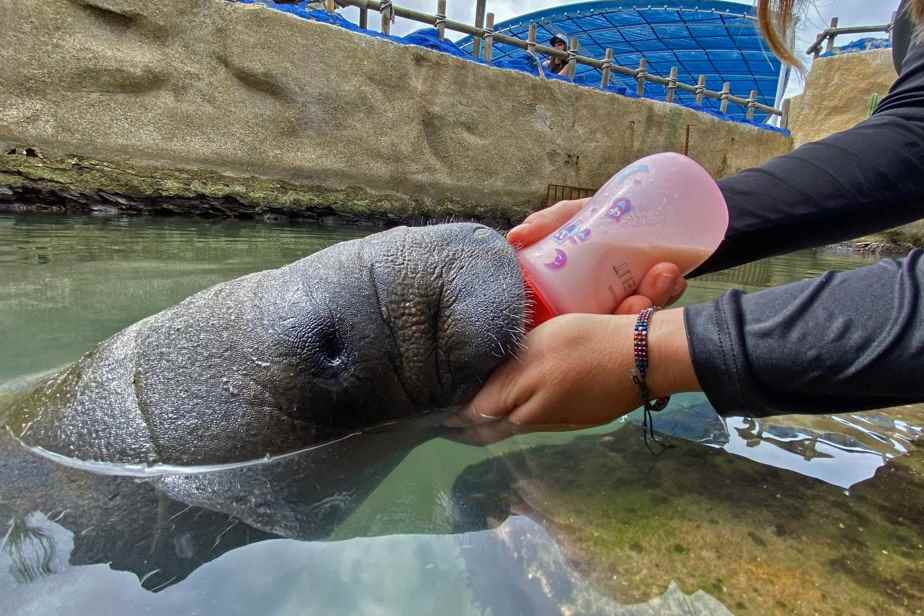(Santa Marta) Tasajerito mesure déjà presque deux mètres mais il ne peut vivre sans son biberon. Retrouvé à la dérive dans un marécage des Caraïbes colombiennes alors qu’il n’avait que trois jours, ce bébé lamantin fait la joie de l’aquarium qui l’accueille en attendant de pouvoir, peut-être un jour, retrouver la liberté.
Publié à 8h46
Les vétérinaires qui le soignent l’ont baptisé du nom du village – Tasajera-, une mince bande de terre qui sépare la mer des Caraïbes de la Cienaga Grande de Santa Marta, dans le nord de la Colombie, où ce doux mammifère aquatique à moustaches a été secouru en septembre par des pêcheurs.
« Nous avons cherché la mère, mais nous ne l’avons pas trouvée, il a donc été déclaré orphelin », raconte à l’AFP Angela Davila, membre de l’équipe vétérinaire chargée de remettre la bête d’aplomb dans un aquarium de la ville de Santa Marta.
Dans le bassin qui lui est spécialement réservé, sous l’œil ravi des visiteurs, le placide herbivore passe ses journées à téter un mélange spécial (à base de lait en poudre pour mammifère marin, vitamines, médicaments et un soupçon d’excréments de lamantin), ayant les mêmes qualités nutritives que le lait maternel dont il se nourrit normalement les deux premières années de sa vie.
Flotter, couler, nager
À son arrivée, le pronostic n’était guère favorable et son état reste « cliniquement critique ».
Au cours des neuf derniers mois, Angela Davila lui a appris « à flotter, à couler, à nager […] functions that a baby normally learns from its mother. But the veterinarians will still have to work for two years with Tasajerito as surrogate mothers.
When the baby manatee will have grown up and will measure between 3 and 4 meters long and weigh around 600 kilos, they will decide if he is fit to regain freedom or if he should remain in captivity.
“The ability of the animal to return to its natural habitat in the marshes will depend on its state of health”, explains veterinarian Julieth Prieto, who emphasizes its “irreplaceable ecological functions” in nature.
Manatees devour up to 50 kilos of aquatic vegetation a day, cleaning up the freshwater channels flowing into the sea and thus helping to control the sedimentation that affects several Colombian rivers.
“If this species were to disappear, we would have to carry out many actions with dredges to improve water flows between rivers, marshes and the sea”, warns Mme Prieto.
There are three species of manatees according to their distribution: African, Amazonian and Caribbean. The latter – Trichechus manatus – to which Tasajerito belongs, extends from the southeast coast of the United States to the Atlantic coast of Brazil.
With an estimated population of 11,000 individuals, the Caribbean manatee is considered vulnerable by the International Union for Conservation of Nature (IUCN).
In Colombia, hunting is the main threat to the manatee, with villagers still consuming its meat. “Their population is very small, we must preserve the few individuals that we have alive”, pleads the veterinarian.
Escobar’s Legacy
Colombia’s placid manatees may soon face another, unexpected danger: Escobar’s hippos.
Imported to Colombia in the 1980s by drug lord Pablo Escobar, a couple has since reproduced uncontrollably and a colony of more than 100 individuals continues to grow in this same region of Santa Marta, higher in altitude. , in an arm of the Magdalena river.
In the future, this much less peaceful species, and recently declared invasive by the authorities, could compete for food with manatees or even change the composition of the water due to the volume of their excrement, according to Nataly Castelblanco, doctor of ecology.
